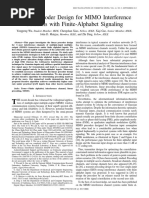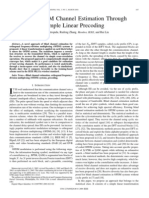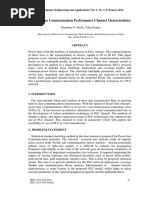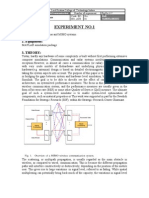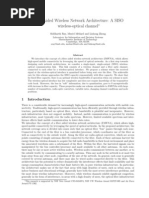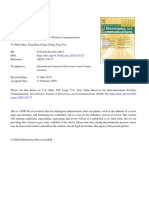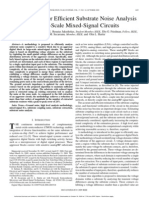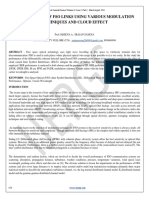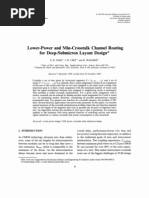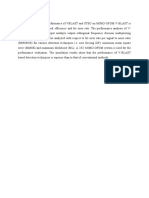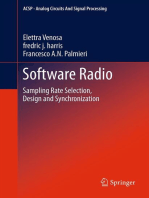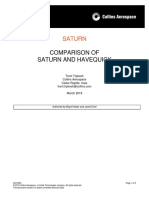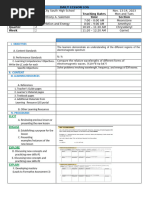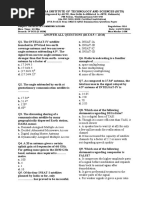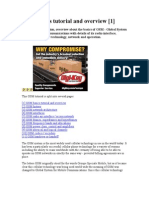J044 Impulse Noise
J044 Impulse Noise
Uploaded by
Muneeb Raees MalikCopyright:
Available Formats
J044 Impulse Noise
J044 Impulse Noise
Uploaded by
Muneeb Raees MalikCopyright
Available Formats
Share this document
Did you find this document useful?
Is this content inappropriate?
Copyright:
Available Formats
J044 Impulse Noise
J044 Impulse Noise
Uploaded by
Muneeb Raees MalikCopyright:
Available Formats
1
Performance of Space-Time Block Coding in
Powerline and Satellite Communications
Anna Papaioannou, Student Member, IEEE, George D. Papadopoulos, Student Member, IEEE, and Fotini-Niovi
Pavlidou, Senior Member, IEEE
AbstractIn this paper Space-Time Block Coding (STBC) is
examined in powerline and satellite communications, comparing
the gains that this coding-modulation technique provides to these
communications systems. The powerline environment is assumed
to be a frequency-selective, multipath fading environment with
Additive White Class A Noise (AWCN), which is used to model
the actual powerline noise characteristics. The satellite channel
for urban area, modeled as a combination of Rayleigh and log-
normal processes with the presence of Additive White Gaussian
Noise (AWGN) is also studied. System efciency is enhanced by
the application of Orthogonal Frequency Division Multiplexing
(OFDM), convolutional coding and block interleaving and the
performance of different Phase Shift Keying (PSK) modulation
schemes under the imposed channel conditions is investigated.
The performance of the system is assessed by the commonly
used Bit Error Rate (BER) vs. Signal to Noise Ratio (SNR)
diagrams and there is also a comparison regarding the through-
put efciency among the examined systems. As stated in the
results section, STBC can be used in powerline and satellite
communications providing remarkable results, comparable to
those in terrestrial wireless communications where STBC is
nowadays a rather mature technique.
Index TermsSpace-Time block coding, powerline communi-
cations, satellite communications, orthogonal frequency division
multiplexing, PSK modulation.
I. INTRODUCTION
T
HE idea of using powerlines to provide information as
well as power is quite old. Powerline Communications
(PLC) offer a potentially convenient and inexpensive solution;
the unique fact that no new wires are needed, the availability of
power outlets in every room and the simplicity of installation
give PLC the opportunity to compete with other last mile
technologies, such as Digital Subscriber Line (DSL) [1],
Wireless Local Loop (WLL), Wireless Local Area Networks
(WLANs), etc. Most of the available PLC systems provide a
maximum data rate of more than several Mbps [2]. However,
the powerline grid can be characterized as a rather hostile
medium for data transmission [3] as it was originally designed
for the distribution of electrical power in the frequency of
50-60Hz. As a consequence, the PLC channel faces some
technical problems, such as impedance variations and mis-
matches, various forms of noise (mainly impulsive noise) and
narrowband interference, multipath propagation phenomena,
high attenuation and other barriers of the medium.
The transmission environment in PLC seems much worse
than that in wireless communications. Thus, not only is it
The authors are with the Department of Electrical and Computer En-
gineering, Aristotle University of Thessaloniki, Panepistimioupolis, 54124
Thessaloniki, Greece. E-mails: {anpapai, papgeo, niovi}@auth.gr.
essential to utilize existing advanced technologies but also
to create novel ones. Several communication techniques have
been suggested for application to the powerline channel. The
objective for reliable communications is to dene a desirable
physical layer design that provides low Bit Error Rates (BERs)
at low received Signal to Noise Ratio (SNR), performs well
in multipath and fading conditions, occupies an affordable
bandwidth, and it is easy and cost effective to be implemented.
Reed-Solomon codes, repetition coding, block and convolu-
tional coding are different forward error correction techniques
that have been proposed for applications recently [4]. Turbo
coding is a fairly new coding technique proposed in [5] for
improving the performance of PLC systems. Besides, space-
time coding is a coding-modulation technique for multiple
emitting and receiving antennas/points [3], which has been
investigated recently in PLC [6][8], as well as in satellite
communications [9][11]. It combines temporal and spatial
diversity in order to provide less attenuated replicas of the
transmitted signal to the receiver and thus to mitigate the
destructive effects of attenuation. Careful studies on possible
transmission techniques are needed in order to aid the decision
procedures for future standards, especially for PLC, where the
standardization is still an open process.
Wireless communications are considered to be a more
convenient way to provide communication services, as the
channel seems to have more favorable propagation character-
istics compared to the PLCs. Therefore, the channel is widely
used for broadband communications, achieving very low BERs
with high data rates, at acceptable SNRs. However, the satellite
channel is quite a difcult channel for communications, facing
different kinds of noise, attenuation and multipath phenomena.
There are several satellite channel models proposed in the
literature, out of which Loos model is investigated in this
work as is described in section II.
The outline of this paper is as follows. In section II, the
channel models are analyzed. The application of Space-Time
Block Coding (STBC) to the channels under study is examined
in section III. The system structure and analysis are delineated
in section IV. The performance evaluation of the system and
extensive simulation results are presented in section V, while
conclusion remarks are drawn in section VI.
II. CHANNEL MODELS
A. Powerline channel
Channel characteristics can be both time- and frequency-
dependent, and also dependent on the location of the trans-
mitter and the receiver in the specic powerline infrastructure.
174 JOURNAL OF COMMUNICATION AND INFORMATION SYSTEMS, VOL. 20, NO. 3, 2005
ISSN 19806604/$20.00 c 2005 SBrT/IEEE
Hence, the channel can be described as random, time varying,
having a frequency-dependent SNR over the communication
bandwidth. As the powerline grid has been designed for the
distribution of energy, the characteristics for data transmission
are rather unfavorable: varying impedance, echoes due to
the impedance discontinuities, considerable noise and high
attenuation. An in-house transfer function, stemming from
measurements, shows some deep narrowband notches spread
over the whole frequency range. The different noise sources,
such as motors, radio signals and power supplies, result in a
noise curve very much dependent on frequency, load, time of
day and geographical location [3].
In contrast to other communication channels, the powerline
channel does not represent an Additive White Gaussian Noise
(AWGN) environment [6]. In the frequency range from some
hundreds of kHz up to 20 MHz, it is mostly dominated by
narrow-band interference and impulsive noise. The impulses
have durations from some microseconds up to a few mil-
liseconds with random arrival times. The most suitable model
for this type of noise is the Additive White Class A Noise
(AWCN).
AWCN is calculated from the combination of AWGN and
impulsive noise. The probability density function (pdf) of a
Class A noise random (complex) variable x is given by [7]:
p(x) =
1
2
m=0
1
2
m
m
exp(
|x|
2
2
2
m
) (1)
where:
m
= e
A A
m
m!
,
2
m
=
2
(m/A)+T
1+T
,
2
is the variance
of the Class A noise, T =
2
g
,
2
g
is the variance of the AWGN
component and
2
is the variance of the impulsive component.
The parameter A is called the impulsive index. For small A,
for example A = 0.1, the noise is highly impulsive, whereas
for A the Class A noise pdf becomes Gaussian.
The samples representing the Class A noise are derived from
[12]:
n = x
G
+
_
K
m
y (2)
where x
G
is a white Gaussian background noise sequence
with zero mean and variance
2
G
, K
m
is a statistically in-
dependent Poisson distributed random sequence whose pdf
is characterized by the parameter A (mean value of Poisson
distribution), and y is a white Gaussian sequence with zero
mean and variance
2
/A. All random sequences in this model
are statistically independent from each other.
Regarding the channel model, there is a lack of a widely
accepted PLC model, although several approaches for indoor
as well as outdoor networks are proposed in the literature as a
result of extensive trials. A signicant work in the area of the
indoor powerline channel modeling is done by Galli et al. in
[13] and [14]. However, this channel model cannot be applied
in our work in the form presented in these papers, because the
Single-Input Single-Output (SISO) case is considered. This
form is not directly applicable to a Multiple-Input Multiple-
Output (MIMO) scenario as the one examined in our paper.
Such an implementation would demand further study on chan-
nel modeling and a different circuit/network topology. Taking
into consideration published as well as our own measurements
[1] in order to have a better insight into the variations of the
channel, an appropriate model was selected for our study. This
is the echo model proposed by Philipps in [15], describing the
transmission characteristics in the frequency range of up to
30MHz.
Hence, the powerline channel can be regarded as a multipath
environment, where transmitted signals arrive at the receiver
not via a direct path, but through N paths, undergoing different
delays and attenuation. The complex attenuation of each path
is:
= |
|e
j
, with
= arctan
_
Im()
Re()
_
, and the N-path
propagation model (impulse response) is given by:
h(t) =
N
=1
|
| e
j
(t
) (3)
where N is the total number of paths,
and
are the
amplitude and the phase of the attenuation factor respectively,
and
is the delay of the signal received by the
th
path.
It can clearly be seen that for each path, a set of only
three parameters (
and
) has to be dened. As a
consequence, the entire model with N paths is completely
dened by 3N parameters. In this study, a 5-path impulse
response provided by the Philipps channel model [15] is taken
into consideration. These parameters are presented in table
I. As one can observe, the sum of the squares of the ve
amplitudes
is far from approaching unity, which is the aim
when as many multipath components as possible are taken into
account. This is due to the fact that the powerline channel
presents much worse transmission conditions compared to
the wireless channel. Thus, each multipath component has
very small amplitude and their sum should include an innite
number of components in order to approach unity.
TABLE I: Set of parameters for the powerline echo model
No. of path in rad in s
1
st
0.151 0.691 0.110
2
nd
0.047 -0.359 0.154
3
rd
0.029 0.591 0.205
4
th
0.041 2.913 0.311
5
th
0.033 1.012 0.427
B. Satellite channel
The noise characterizing the satellite channel is AWGN.
The so-called Land Mobile Satellite (LMS) channel can be
modeled as a sum of three components: two coherent (direct
wave and specular wave) and an incoherent one (diffuse wave)
[16]. The direct component is received through a line-of-
sight (LOS) path. Shadowing is the attenuation of the direct
component, caused by any type of obstacles (trees, buildings,
hills or mountains). The specular component is generated by
signal reection from the ground, while the diffuse component
of the received signal is a multipath wave due to reections and
scattering from the space around the receiver. This component
is responsible for the small-scale variations of the signals
amplitude and phase. From the above we can reach the
conclusion that shadowing and multipath are the processes that
dominate the LMS channel.
JOURNAL OF COMMUNICATION AND INFORMATION SYSTEMS, VOL. 20, NO. 3, 2005 175
The log-normal distribution is widely used to describe the
large-scale fading, which refers to the variations of the signal
amplitude caused by the attenuation of the LOS path. The
receiver is also surrounded by a large number of scattering
objects and multipath propagation mechanism is also an issue
to consider. Hence, in urban environments, multipath is well
described by the Rayleigh distribution. The resultant distribu-
tion, aiming at the description of both small and large-scale
fading, is a combination of the above mentioned distributions.
In this work, the LMS channel is modeled using Loos
model, referred to in [16], which is a narrow-band, global
statistical (rst order statistics) channel model. The so-called
specular component of the received signal is ignored and
only the direct as well as the diffuse-multipath component are
taken into consideration. The direct component suffers from
shadowing, while the diffuse component has constant power.
The mathematical expression describing the channel process
r is:
r = Se
j0
+Re
j
(4)
where the sequence S, which corresponds to the direct com-
ponent (log-normal envelope), is added to the sequence R,
which represents the diffuse component (Rayleigh envelope),
and
0
, are uniformly distributed sequences.
III. SPACE TIME BLOCK CODING
Space-time coding has comprehensively been studied in ter-
restrial wireless channels with very good performance results.
The fundamental phenomenon that makes reliable wireless
transmission a hard task is time-varying multipath fading [17].
In most cases, the wireless channel suffers from attenuation
due to the destructive addition of multipaths in the propagation
media and interference from other users [18].
Reducing the error rate in a multipath fading environment is
not an easy task. Theoretically, the most effective technique to
mitigate multipath fading in a wireless channel [17], as well as
in PLC, is transmitter power control. However, the improve-
ment in SNR may not be achieved by higher transmit power
(causing Electromagnetic Compatibility -EMC- problems) or
additional bandwidth.
Another effective technique is diversity, which can be
provided using temporal, frequency, polarization and spa-
tial resources [18]. In most scattering environments, antenna
diversity is a practical and widely applied method aiming
at ameliorating the detrimental effects of multipath fading.
Space-time coding implements the idea of using multiple
transmitting and multiple receiving antennas by the linear
combination of the transmitted signal at the transmitter, while
the inverse process takes place at the receiver [17].
The application of STBC to the powerline channel presents
some basic differences in comparison with the wireless chan-
nel. In wireless communications multiple transmitting and
receiving antennas can be used. In the PLC environment,
where the implementation of space-time codes can take ad-
vantage of the intrinsic spatial diversity in the use of a three-
phase powerline network [19], there exist two cases: the rst
scenario considers three emitting and three receiving points
[6], which are the three phases of the powerline channel, and
can be applied to the last mile environment. The second
one, proposed in this paper, implements two emitting and two
receiving points assuming communication via two channels,
phase - protective earth and neutral - protective earth and
can be applied to an in-home network (LAN). This decision
was taken under the consideration of [20], where the SISO
case is described. Besides, in wireless communications with
multiple transmitting and receiving antennas, the signal at the
input of each receiving antenna is calculated through the linear
combination of the transmitted signals of all the transmitting
antennas. On the other hand, in PLC, the wires are assumed to
be completely isolated [6]. This consideration is an assumption
made in this work, which simplies the signal transmission
through the powerline channel [13]. However, in the actual
powerline network there is energy transfer between the wires,
due to wiring and grounding practices, which can lead to
diversity gain at the receiver. In the wireless case the diversity
order is M N for M transmitting and N receiving antennas.
Space-Time Block Codes are dened by the transmission
matrix G. In our system the general structure of the transmis-
sion matrix, employing two transmitting and two receiving
points for complex orthogonal design [21], is:
G
2
c
=
_
x
1
x
2
x
2
x
1
_
(5)
where the i-th row represents the symbols transmitted during
the i-th time slot and the j-th column the symbols transmitted
from the j-th emitting point. Generally, the code rate is dened
as R = k/p, since p time slots are used to transmit k symbols
[18]. For complex constellations, the transmission matrix with
dimensions 2x2 is the only one that can achieve rate 1 [7],
which is also the case investigated in this work.
The inverse process takes place at the receiver, where the
space-time decoding is performed. Assuming two transmitting
(Tx
1
, Tx
2
) and two receiving antennas (Rx
1
, Rx
2
) (gure 1
case b), the received signals are:
r
0
= r
1
(t) = h
0
x
1
+h
1
x
2
+n
0
r
1
= r
1
(t +T) = h
0
x
2
+h
1
x
1
+n
1
r
2
= r
2
(t) = h
2
x
1
+h
3
x
2
+n
2
r
3
= r
2
(t +T) = h
2
x
2
+h
3
x
1
+n
3
(6)
where h
0
, h
1
, h
2
, h
3
are the channel gains between Tx
1
and
Rx
1
, Tx
2
and Rx
1
, Tx
1
and Rx
2
, Tx
2
and Rx
2
respectively,
and n
0
, n
1
, n
2
, n
3
are the noise and the interference samples.
Fig. 1: Space-Time Block Coding Transmission
176 JOURNAL OF COMMUNICATION AND INFORMATION SYSTEMS, VOL. 20, NO. 3, 2005
The combiner constructs the symbols x
1
and x
2
given
below, which are then sent to the detector.
x
1
= h
0
r
0
+h
1
r
1
+h
2
r
2
+h
3
r
3
x
2
= h
1
r
0
h
0
r
1
+h
3
r
2
h
2
r
3
(7)
For Phase Shift Keying (PSK) signals [17], the maximum
likelihood (ML) detector computes the square of the Euclidean
distance between x
1
and each constellation symbol x
k
, and
decides in favor of x
i
if:
d
2
(x
1
, x
i
) d
2
(x
1
, x
k
), i = k (8)
For the powerline channel with two emitting and two
receiving points (gure 1, case a), perfect isolation between
the wires is assumed. Thus, equations (6) are simplied:
r
0
= r
1
(t) = h
0
x
1
+n
0
r
1
= r
1
(t +T) = h
0
x
2
+n
1
r
2
= r
2
(t) = h
1
x
2
+n
2
r
3
= r
2
(t +T) = h
1
x
1
+n
3
(9)
The ML detector receives the combined signals:
x
1
= h
0
r
0
+h
1
r
3
x
2
= h
0
r
1
+h
1
r
2
(10)
and uses the decision criterion of (8).
Furthermore, the channel capacity is examined. For a SISO
system, the capacity expressed in bits/sec/Hz is given by:
C = log
2
(1 +|h|
2
) (11)
where h is the normalized complex gain of a particular
realization of a random channel and is the SNR at any
transmitting antenna [22].
The channel capacity for a MIMO system with N transmit-
ting and M receiving antennas is computed using the equation
from [23]:
C = log
2
_
det
_
I
M
+
N
HH
__
(12)
where H is the M N channel matrix and (
) denotes the
transpose-conjugate.
When STBC is used, the channel capacity is given by [24]:
C = Rlog
2
_
1 +
1
NR
SNR
M
m=1
N
n=1
|h
n,m
|
2
_
(13)
where SNR is the total mean signal to noise power ratio at
each receiving antenna, R is the space-time code rate and
h
n,m
is the channel gain from the transmitting antenna n
to the receiving antenna m. Equation (13) can be written
equivalently:
C = Rlog
2
_
1 +
1
NR
SNRH
2
F
_
(14)
where H
2
F
is the squared Frobenius norm of channel matrix
H.
The use of the Shannons standard capacity formula C =
BW log
2
(1 + SNR) is not directly applicable to powerline
channels, since the SNR is not constant within the bandwidth
BW [25]. Thus, the capacity is computed taking into account
the received signal power spectral density (PSD)
r
(f) and a
frequency dependent noise PSD
n
(f):
C =
fU
_
fL
log
2
_
1 +
r
(f)
n
(f)
_
df, withBW = f
U
f
L
(15)
where
r
(f) =
t
(f) |H(f)|
2
,
t
(f) is the transmission
PSD and H(f) is the channel transfer function. Considering
the SNR at the transmitter
t(f)
n(f)
in dB, the powerline channel
capacity can be computed by equation (15) in the frequency
range of 1-30 MHz.
IV. SYSTEM STRUCTURE AND ANALYSIS
The general layout of the simulated system can be seen in
gure 2. The data to be transmitted is rst coded with convolu-
tional coding (2,1) with generator polynomial [133,171]. The
reason for utilizing convolutional coding is that it is widely
used in the literature with very good performance results.
However, in fading channels with high levels of impulsive
noise, like the powerline channel, errors have a bursty nature.
This can be controlled by using burst error correcting tech-
niques, i.e. block interleaving [26]. In this work the signal is
block interleaved with interleaving depth 40.
data
bits Convolutional
Encoder
Interleaver
PSK
Modulator
OFDM Tx
Space-Time
Block Coder
Channel
Space-Time
Block Decoder
OFDM Rx
PSK
Demodulator
Deinterleaver
Convolutional
Decoder
data
bits
Fig. 2: System Structure
The modulation schemes under examination are the com-
monly used Binary Phase Shift Keying (BPSK) and Quadra-
ture Phase Shift Keying (QPSK), which are the most popular
in applications to wireless and powerline channels today. The
signal power for both modulation schemes is normalized to
unity.
Orthogonal Frequency Division Multiplexing (OFDM) is
a multicarrier modulation scheme suitable for PLC due to
its ability to deal with multipath propagation, intersymbol
interference and frequency selective channels. In OFDM the
signal is modulated through 512 carriers, equally spaced within
the frequency range from 1 to 30 MHz. The guard time in the
case of the satellite channel is a quarter of the OFDM symbol
duration, while for the powerline channel the guard time is
chosen to be 0.5 sec, greater than the maximum delay spread
(0.427 sec).
The STBC scheme applied in our study utilizes two emitting
points / antennas and two receiving points/ antennas for the
examined channels (hereafter referred to as STBC2x2). The
transmission matrix used to produce the space-time encoder
and decoder was described in (5). For the PLC application it
is essential to use equal number of transmitting and receiving
points. On the contrary, implementation in wireless channels
employs an arbitrary number of antennas. However, STBC2x2
is studied for both the powerline and the satellite environment.
JOURNAL OF COMMUNICATION AND INFORMATION SYSTEMS, VOL. 20, NO. 3, 2005 177
The Class A noise is characterized by three parameters
[27], which were mentioned in section II-A. These are the
impulsive index A, the variance of the AWGN component
2
g
and the ratio T. Based on [27], A is set equal to 0.25,
2
g
= 10
3
W and T = 0.001. The parameter A determines the
impulsiveness of Class A noise (i.e. it is the product of the
mean number of impulses per second and the mean length of
an impulse in seconds). Comparing with other impulsive noise
scenarios studied in [28], it can be concluded that choosing A
to be 0.25 represents very heavy noise conditions.
In the following section, simulation results for the terrestrial
wireless channel are also presented, for the sake of comparison
with the benets that STBC can offer to powerline and satellite
channels. For the terrestrial wireless channel, the channel gains
are modeled as samples of independent complex Gaussian
random variables with variance 0.5 per real dimension, which
results in a Rayleigh distribution with variance 1 [7]. The path
gains used for the simulation of the powerline channel are
given in table I. For the satellite channel, the channel gains are
given by the sum of a log-normal and a Rayleigh distribution
as described in section II-B. It should be mentioned here that
perfect channel estimation at the receiver is assumed in all
cases.
V. PERFORMANCE EVALUATION AND SIMULATION
RESULTS
For the performance evaluation of the proposed systems, a
simulation was developed in Matlab. The gures presented at
the end of the paper were obtained by averaging the results of
multiple simulation runs, in order to minimize the statistical
errors and to assure the validity of the results. The system was
evaluated by simulating a transmission of about 2
20
(1048576)
data bits, so as to derive the performance results for each
one of the tested systems. The multiparametric nature of the
simulation should be mentioned, including the following: bits
per symbol, modulation techniques and interleaving depth.
These are the major parameters with which we tested the
system performance for several values and combinations, in
order to decide on the optimal ones. In this section, the BER
Fig. 3: BER performance for the PLC channel using BPSK
modulation
Fig. 4: BER performance for the PLC channel using QPSK
modulation
and the bitrate performance of the aforementioned systems are
presented for a wide range of SNRs.
In gures 3 and 4 the PLC channel is examined using
BPSK and QPSK modulations respectively. In the rst case,
it is apparent that even a simple convolutional code combined
with interleaving yields much better results compared to the
uncoded transmission. When STBC is applied the system
performs even better, with STBC inducing a gain of about 16
dB at a BER of 10
5
. In the case that the signal is modulated
with QPSK, the results of the simulation show that low BER
can be achieved only by the implementation of space-time
coding, otherwise increasing the SNR does not improve the
performance. Based on [28], this error oor can be justied
as a result of the very heavy impulsive noise scenario used
in our work. The overall results are still worse than those for
BPSK, as expected.
The results for the satellite channel are presented in gures
5 and 6. In the case that BPSK is implemented (gure 5),
the scheme without STBC reaches a BER of 10
5
at an
SNR of 32.5 dB, while the STBC2x2 attains the same BER
at about 14 dB. Regarding the QPSK system in gure 6, a
Fig. 5: BER performance for the satellite channel using BPSK
modulation
178 JOURNAL OF COMMUNICATION AND INFORMATION SYSTEMS, VOL. 20, NO. 3, 2005
Fig. 6: BER performance for the satellite channel using QPSK
modulation
deterioration to the previous gures curves can be observed
when comparing the two modulation schemes. It can be stated
here that STBC2x2 offers less gain to the non-STBC system
(12.5 dB at a BER of 10
5
) than that in the BPSK case.
Results for the terrestrial wireless channel are presented in
gures 7 and 8 as a reference for comparison with powerline
and satellite channels. In gure 7, where BPSK modulation is
applied, STBC is quite benecial, as it can reduce the required
SNR by more than 16 dB at a BER of 10
5
compared to the
system without STBC. Figure 8 depicts the efciency of the
QPSK modulation. The system performance shows a similar
behaviour as with BPSK, with STBC2x2 providing a gain of
16 dB at a BER of 10
5
compared to the case without STBC.
Fig. 7: BER performance for the terrestrial wireless channel
using BPSK modulation
As a general comment, it can be seen that STBC is protable
not only for terrestrial wireless communications, but for PLC
and satellite communications as well. Regarding the PLC
channel, STBC seems more benecial when the signal is
modulated with QPSK than with BPSK. It can be observed
in all gures that the utilization of STBC2x2 offers a great
improvement compared to the non-STBC system.
The capacity of systems under study is presented in gures
Fig. 8: BER performance for the terrestrial wireless channel
using QPSK modulation
9 - 11. For the powerline channel, the capacity with respect
to mean receiver SNR is computed in the frequency range of
1-30 MHz for both the SISO and the STBC2x2 cases (gure
9). As it can be noticed, there is almost no difference between
the SISO and the STBC2x2 capacities. This happens due to
the considered assumption (isolation of the two wires). If we
Fig. 9: Capacity for powerline channel
Fig. 10: Ergodic capacity for satellite channel
JOURNAL OF COMMUNICATION AND INFORMATION SYSTEMS, VOL. 20, NO. 3, 2005 179
Fig. 11: Ergodic capacity for terrestrial wireless channel
had not taken into account this assumption, better behaviour
of the capacity would be expected when using STBC, because
the diversity gain would increase. On the contrary, regarding
the ergodic (mean) capacity comparison in gures 10 and 11, it
can be seen that STBC2x2 offers higher capacity to the system
than the SISO case. It is known that a full rate STBC, used
over any channel with one receive antenna, is always optimal
with respect to capacity [22] and that capacity increases with
increasing number of antennas, due to diversity order. The
improvement in capacity is more evident for the satellite
channel compared to the wireless channel. The amelioration
that STBC provides to the capacity of the wireless systems is
obvious, in contrast to the powerline system.
VI. CONCLUSIONS
This paper examines the BER performance as well as the
channel capacity of an STBC system, for both powerline and
satellite channels. BPSK and QPSK modulations combined
with convolutional code are also investigated. In addition,
OFDM is implemented in order to reinforce systems robust-
ness against multipath propagation phenomena and interfer-
ence. Interleaving is also evaluated as means to improve this
performance.
The STBC application appears to be quite benecial in
terms of the BER performance for both the PLC and the LMS
channel. STBC seems to provide a gain of more than 10 dB at
a BER of 10
5
in comparison with the non-STBC system, for
the two modulation schemes and the different communication
environments. The capacity of the wireless simulated systems
seems to increase when STBC of rate one is applied, while for
PLC it remains the same. The overall conclusion coming out of
this study is that both powerline and satellite communications
can prot a lot from the implementation of this coding-
modulation technique.
In conclusion, it should be pointed out that there is a lot
of further research to be done, investigating the application
of STBC in the powerline and satellite communications. For
future work towards this direction we intend to study how
the efciency of STBC is affected, examining in depth the
MIMO powerline channel modeling and the effect of the noise
correlation in the powerline network.
REFERENCES
[1] C. Assimakopoulos, P. L. Katsis, F.-N. Pavlidou, D. Obradovic, and
M. Obradovic, xDSL Techniques for Power Line Communications,
in Proc. of International Symposium on Power-Line Communications
and Its Applications 2003 (ISPLC 2003), Kyoto, Japan, Mar. 2003, pp.
2125.
[2] W. Liu, H. Widmer, and P. Rafn, Broadband PLC Access Systems and
Field Deployment in European Power Line Networks, IEEE Commun.
Mag., vol. 41, no. 5, pp. 114118, May 2003.
[3] F.-N. Pavlidou, A. J. H. Vinck, and J. Yazdani, Power Line Commu-
nications: State of the Art and Future Trends, IEEE Commun. Mag.,
vol. 41, no. 4, pp. 3440, Apr. 2003.
[4] P. L. Katsis, G. D. Papadopoulos, and F.-N. Pavlidou, Coded MC-
CDMA Systems for Power Line Communications, in TELSIKS 2003,
Nis, Serbia and Montenegro, Oct. 2003, pp. 153156.
[5] P. Katsis, G. Papadopoulos, and F.-N. Pavlidou, Comparison of Coded
Orthogonal Frequency Division Multiplexing and Multicarrier Code
Division Multiple Access Systems for Power Line Communications,
International Journal of Communication Systems (IJCS), vol. 17, no. 9,
pp. 833850, Nov. 2004.
[6] C. L. Giovaneli, P. Farrell, and B. Honary, Application of Space-
Time Block Codes for Power Line Communication Channels, in Proc.
of Communication Systems, Networks and Digital Signal Processing
Symposium, Staffordshire, U.K., July 2002.
[7] C. L. Giovaneli, J. Yazdani, P. Farrell, and B. Honary, Application
of Space-Time Diversity/Coding for Power Line Channels, in Proc.
of International Symposium on Power-Line Communications and Its
Applications 2002 (ISPLC 2002), Athens, Greece, Mar. 2002, pp. 101
105.
[8] A. Papaioannou, G. D. Papadopoulos, and F.-N. Pavlidou, Performance
of Space-Time Block Coding over the Power Line Channel in Compari-
son with the Wireless Channel, in Proc. of International Symposium on
Power-Line Communications and Its Applications 2004 (ISPLC 2004),
Saragossa, Spain, Apr. 2004, pp. 362366.
[9] M. Uysal and C. N. Georghiades, Effect of Shadowing on the Per-
formance of Space-Time Trellis-Coded Systems, IEEE Trans. Wireless
Commun., vol. 3, no. 4, pp. 10371042, July 2004.
[10] M. Uysal, Pairwise Error Probability of Space-Time Codes in Rician-
Nakagami Channels, IEEE Commun. Lett., vol. 8, no. 3, pp. 132134,
Mar. 2004.
[11] R. Tesi, D. Tujkovic, E. Kunnari, and L. Mucchi, Space-Time Coded
Satellite Diversity in S-UMTS, in 7th International Workshop on Digi-
tal Signal Processing Techniques for Space Communications, Sesimbra,
Portugal, Oct. 2001.
[12] G. Pay and M. Safak, Performance of DMT Systems under Impulsive
Noise, in Proc. of International Symposium on Power-Line Communi-
cations and Its Applications 2001 (ISPLC 2001), Malmo, Sweden, Apr.
2001, pp. 109114.
[13] S. Galli and T. C. Banwell, Modeling the Indoor Power Line Channel:
New Results and Modem Design Considerations, in Proc. of IEEE
Consumer Communications and Networking Conference (CCNC04),
Las Vegas, USA, Jan. 2004.
[14] S. Galli and T. Banwell, A Novel Approach to the Modeling of
the Indoor Power Line Channel - Part II: Transfer Function and Its
Properties, IEEE Trans. Power Delivery, vol. 20, no. 3, pp. 18691878,
July 2005.
[15] H. Philipps, Modelling of Powerline Communication Channels, in
Proc. of International Symposium on Power-Line Communications and
Its Applications 1999 (ISPLC 1999), Lancaster, UK, Mar. 1999, pp. 14
21.
[16] M. Karaliopoulos and F.-N. Pavlidou, A Review on Modeling of the
Land Mobile Satellite Channel, IEE Electronics and Communication
Engineering Journal, vol. 11, no. 5, pp. 235248, Oct. 1999.
[17] S. M. Alamouti, A Simple Transmit Diversity Technique for Wireless
Communications, IEEE J. Select. Areas Commun., vol. 16, no. 8, pp.
14511458, Oct. 1998.
[18] V. Tarokh, H. Jafarkhami, and A. R. Calderbank, Space-Time Block
Coding for Wireless Communications: Performance Results, IEEE J.
Select. Areas Commun., vol. 17, no. 3, pp. 451460, Mar. 1999.
[19] E. Biglieri, Coding and Modulation for a Horrible Channel, IEEE
Commun. Mag., vol. 41, no. 5, pp. 9298, May 2003.
[20] K. Dostert, Powerline Communications. New Jersey: Prentice Hall,
2001.
[21] V. Tarokh, H. Jafarkhami, and A. R. Calderbank, Space-Time Block
Codes from Orthogonal Designs, IEEE Trans. Inform. Theory, vol. 45,
no. 5, pp. 14561467, July 1999.
180 JOURNAL OF COMMUNICATION AND INFORMATION SYSTEMS, VOL. 20, NO. 3, 2005
[22] S. Sandhu and A. Paulraj, Space-Time Block Codes: A Capacity
Perspective, IEEE Commun. Lett., vol. 4, no. 12, pp. 384386, Dec.
2000.
[23] D. Gesbert, M. Sha, D.-S. Shiu, P. J. Smith, and A. Naguib, From
Theory to Practice: An Overview of MIMO Space-Time Coded Wireless
Systems, IEEE J. Select. Areas Commun., vol. 21, no. 3, pp. 281302,
Apr. 2003.
[24] H. C. Espinosa, J. R. Fonollosa, and J. A. D. Penin, Channel Capacity
of Space-Time Block Coding, in IST Mobile Communications Summit
2001, Sitges (Barcelona), Spain, Sept. 2001.
[25] K. Dostert, New PLC Approaches for High Speed Indoor Digital
Networks, in Proc. of International Symposium on Power-Line Com-
munications and Its Applications 2001 (ISPLC 2001), Malmo, Sweden,
Apr. 2001, pp. 253258.
[26] J. G. Proakis and M. Salehi, Communication System Engineering. New
Jersey: Prentice Hall, 1994.
[27] L. A. Berry, Understanding Middletons Canonical Formula for Class A
Noise, IEEE Trans. Electromagn. Compat., vol. 23, no. 4, pp. 337344,
Nov. 1981.
[28] Y. H. Ma, P. L. So, E. Gunawan, and Y. L. Guan, Modeling and
Analysis of the Effect of Impulsive Noise on Broadband PLC Networks,
in Proc. of International Symposium on Power-Line Communications
and Its Applications 2004 (ISPLC 2004), Saragossa, Spain, Apr. 2004,
pp. 4550.
Anna Papaioannou received the Diploma in Elec-
trical and Computer Engineering from the Aristotle
University of Thessaloniki, Greece in 2003. She is
currently a PhD candidate at the same department.
Her research interests include coding and mod-
ulation techniques for powerline communications,
space-time coding, cooperative diversity and phy-
mac cross-layer design. She is a student member of
the IEEE and a member of the Technical Chamber
of Greece.
George D. Papadopoulos received his Diploma
in Electrical and Computer Engineering from the
Aristotle University of Thessaloniki, Greece in 2002.
He is currently a Ph.D candidate in the same
department. His research interests include coding
techniques and multicarrier systems in multipath and
fading channels, such as wireless and powerline
communications. He has been involved in many
research European and national projects and he has
served as a reviewer for many IEEE/IEE journals and
conferences. He is teaching in the aforementioned
department. He is a student member of the IEEE and a member of the
Technical Chamber of Greece.
Fotini-Niovi Pavlidou received the PhD degree and
the Diploma in Electrical Engineering from the Aris-
totle University of Thessaloniki (AUTh), Greece,
in 1988 and in 1979 respectively. She is with the
Dept. of Electrical and Computer Engineering at
AUTh engaged in teaching in the areas of Mobile
communications and Telecommunications Networks.
Her research interests are in the eld of mobile and
personal communications, satellite communications,
multiple access systems, routing and trafc ow in
networks and QoS studies for multimedia applica-
tions over the Internet. She is participating in many national and international
projects (Tempus, COST, Telematics, IST) and she has been chairing the
European COST262 Action on Spread Spectrum Systems and Techniques
for Wired and wireless Communications. She has served as member of
the TPC in many IEEE/IEE conferences and she has organized/chaired
some conferences like, the IST Mobile Summit2002, the 6th International
Symposium on Power Lines Communications-ISPLC2002, the International
Conference on Communications-ICT1998 etc. She is a permanent reviewer
for many IEEE/IEE journals. She has published more than 100 papers in
refereed journals and conferences. She has served as guest-editor for special
issues in many journals. She is a senior member of IEEE, currently chairing
the joint IEEE VT&AES Chapter in Greece.
JOURNAL OF COMMUNICATION AND INFORMATION SYSTEMS, VOL. 20, NO. 3, 2005 181
You might also like
- Performance Analysis of OFDM For 4G Wireless Systems Under Various Fading ChannelsDocument4 pagesPerformance Analysis of OFDM For 4G Wireless Systems Under Various Fading ChannelsJuan Dela CruzNo ratings yet
- Linear Precoder Design For MIMO Interference Channels With Finite-Alphabet SignalingDocument15 pagesLinear Precoder Design For MIMO Interference Channels With Finite-Alphabet SignalinglfklasNo ratings yet
- Capacity of Rayleigh Fading Channels Under Different Adaptive Transmission and Diversity-Combining TechniquesDocument17 pagesCapacity of Rayleigh Fading Channels Under Different Adaptive Transmission and Diversity-Combining Techniqueseng2003No ratings yet
- New Transceiver Scheme For OFDM-Based Broadband Power Line CommunicationsDocument12 pagesNew Transceiver Scheme For OFDM-Based Broadband Power Line CommunicationsDomRuanNo ratings yet
- OFDM Versus Single-Carrier Transmission For 100 Gbps Optical CommunicationDocument15 pagesOFDM Versus Single-Carrier Transmission For 100 Gbps Optical Communicationawais04No ratings yet
- Modeling of Power Line Communications Using MIMO Coding Scheme For Indoor SystemDocument11 pagesModeling of Power Line Communications Using MIMO Coding Scheme For Indoor SystemNoorianah LollmahamodNo ratings yet
- Blind OFDM Channel Estimation Through Simple Linear PrecodingDocument9 pagesBlind OFDM Channel Estimation Through Simple Linear Precodingkvkumar294No ratings yet
- Power Line Communication Performance Channel CharacteristicsDocument10 pagesPower Line Communication Performance Channel CharacteristicsGiNo ratings yet
- Experiment No.1: 1. AIM: 2. EquipmentDocument7 pagesExperiment No.1: 1. AIM: 2. EquipmentNilesh RathoreNo ratings yet
- 1 PB PDFDocument9 pages1 PB PDFMokone Pro MokoneNo ratings yet
- 06398080Document5 pages06398080Rasool ReddyNo ratings yet
- Fiber Aided Wireless Network Architecture: A SISO Wireless-Optical ChannelDocument10 pagesFiber Aided Wireless Network Architecture: A SISO Wireless-Optical ChannelNitin SahuNo ratings yet
- Journal Pre-Proofs: International Journal of Electronics and Commu-NicationsDocument23 pagesJournal Pre-Proofs: International Journal of Electronics and Commu-NicationsSebastian LopezNo ratings yet
- Power Line CommunicationDocument17 pagesPower Line Communicationvyshakhpc0No ratings yet
- 2012 TWCDocument12 pages2012 TWChassan abousalehNo ratings yet
- ThesisMaster1 PDFDocument195 pagesThesisMaster1 PDFchandanjha2010No ratings yet
- Uplink Channel Capacity of Space-Division-Multiple-Access SchemesDocument9 pagesUplink Channel Capacity of Space-Division-Multiple-Access SchemesAzhar UddinNo ratings yet
- Optimal Soft Frequency Reuse and Dynamic Sub-Carrier Assignments in Cellular OFDMA NetworksDocument10 pagesOptimal Soft Frequency Reuse and Dynamic Sub-Carrier Assignments in Cellular OFDMA NetworksBudi Agus SetiawanNo ratings yet
- Methodology For Efficient Substrate Noise Analysis in Large-Scale Mixed-Signal CircuitsDocument14 pagesMethodology For Efficient Substrate Noise Analysis in Large-Scale Mixed-Signal Circuits원성규No ratings yet
- Ofdm Articl SimulDocument8 pagesOfdm Articl SimulazerNo ratings yet
- Analysis of Pre-Emphasis Techniques For Channels With Higher-Order Transfer FunctionDocument12 pagesAnalysis of Pre-Emphasis Techniques For Channels With Higher-Order Transfer FunctionPraveen KumarNo ratings yet
- An Experimental OFDM-Modem For The CENELEC B-BandDocument8 pagesAn Experimental OFDM-Modem For The CENELEC B-Bandu235861No ratings yet
- An Overview of The Trans Miss On Capacity of Wireless NetworksDocument22 pagesAn Overview of The Trans Miss On Capacity of Wireless Networksajay5bsNo ratings yet
- Bit Error Rate and Signal To Noise Ratio Performance Evaluation of OFDM System With QPSK and QAM MDocument16 pagesBit Error Rate and Signal To Noise Ratio Performance Evaluation of OFDM System With QPSK and QAM MPhilip KpaeNo ratings yet
- Multipath PLCDocument7 pagesMultipath PLCYaw SekyereNo ratings yet
- Multiple Carriers in Wireless Communications - : Curse or Blessing?Document9 pagesMultiple Carriers in Wireless Communications - : Curse or Blessing?Amit ShivhareNo ratings yet
- Investigating 802.11A Wireless Standard For High Speed Network Using Different Modulation TechniquesDocument5 pagesInvestigating 802.11A Wireless Standard For High Speed Network Using Different Modulation TechniqueserpublicationNo ratings yet
- On Beamforming With Finite Rate Feedback in Multiple-Antenna SystemsDocument18 pagesOn Beamforming With Finite Rate Feedback in Multiple-Antenna SystemsFahd SaifNo ratings yet
- Study of Harmonics in Cable Based Transmission Networks PDFDocument14 pagesStudy of Harmonics in Cable Based Transmission Networks PDFCarlos Lino Rojas AgüeroNo ratings yet
- Transactions Papers: Rickard Stridh, Mats Bengtsson, and BJ Orn OtterstenDocument9 pagesTransactions Papers: Rickard Stridh, Mats Bengtsson, and BJ Orn OtterstenYuvaraj KrishnanNo ratings yet
- Performance of Fso Links Using Various Modulation Techniques and Cloud EffectDocument6 pagesPerformance of Fso Links Using Various Modulation Techniques and Cloud EffectJabeena AfthabNo ratings yet
- A Highly Flexible and Efficient Passive Optical Network Employing Dynamic Wavelength AllocationDocument10 pagesA Highly Flexible and Efficient Passive Optical Network Employing Dynamic Wavelength AllocationRizwan Aslam ButtNo ratings yet
- Statistical Wireless Fading ChannelDocument55 pagesStatistical Wireless Fading ChannelAzim KhanNo ratings yet
- Efficient Analysis of The Ergodic Capacity of Cooperative Non-Regenerative Relay Networks Over Generalized Fading ChannelsDocument21 pagesEfficient Analysis of The Ergodic Capacity of Cooperative Non-Regenerative Relay Networks Over Generalized Fading ChannelsJohn BergNo ratings yet
- Simulation of MIMO Antenna Systems in Simulink and Embedded MatlabDocument6 pagesSimulation of MIMO Antenna Systems in Simulink and Embedded Matlabdeva singhNo ratings yet
- The Effects of Load Impedance, Line Length, and Branches in The BPLC-Transmission-Lines Analysis For Medium-Voltage ChannelDocument7 pagesThe Effects of Load Impedance, Line Length, and Branches in The BPLC-Transmission-Lines Analysis For Medium-Voltage ChannelAhmed AbozahrahNo ratings yet
- A Simple Transmit Diversity Technique For Wireless CommunicationsDocument8 pagesA Simple Transmit Diversity Technique For Wireless Communicationshanlee890No ratings yet
- Lower-Power: LayoutDocument11 pagesLower-Power: LayoutmturadagiNo ratings yet
- Research On Channel ModelingDocument16 pagesResearch On Channel ModelingSajal SouravNo ratings yet
- Energy-Efficiency of MIMO and Cooperative MIMO Techniques in Sensor NetworksDocument10 pagesEnergy-Efficiency of MIMO and Cooperative MIMO Techniques in Sensor Networksapi-127299018No ratings yet
- Performance Analysis of Efficient and Low Complexity MIMO-OFDM Using STBC and V-BLASTDocument66 pagesPerformance Analysis of Efficient and Low Complexity MIMO-OFDM Using STBC and V-BLASTDheeksha ReddyNo ratings yet
- FB JournalDocument43 pagesFB JournalKehindeOdeyemiNo ratings yet
- Performance Analysis of Iterative IDMA Scheme in Power Line Communication Using Random InterleaverDocument5 pagesPerformance Analysis of Iterative IDMA Scheme in Power Line Communication Using Random InterleaverAlexander DeckerNo ratings yet
- BinderDocument1 pageBinderRajni GargNo ratings yet
- Capacity Bounds For Cooperative Diversity: Anders Høst-Madsen, Senior Member, IEEEDocument23 pagesCapacity Bounds For Cooperative Diversity: Anders Høst-Madsen, Senior Member, IEEEdeepaneceNo ratings yet
- (ARTICLE) Optical Burst and Packet Switching - Node and Network Design Contention Resolution and Quality of ServiceDocument8 pages(ARTICLE) Optical Burst and Packet Switching - Node and Network Design Contention Resolution and Quality of ServiceGhallab AlsadehNo ratings yet
- Analytical Description of Signal Characteristics and Interference For Time Hopped UWB SystemDocument5 pagesAnalytical Description of Signal Characteristics and Interference For Time Hopped UWB SystemΓιώργος ΤσιτσίκαςNo ratings yet
- Resource Sharing in 5G Mmwave Cellular NetworksDocument7 pagesResource Sharing in 5G Mmwave Cellular NetworksTiago NunesNo ratings yet
- Spectrum Sharing in Wireless Networks - A QOS-Aware Secondary Multicast Approach With Worst User Performance Optimization, 2008 IEEEDocument5 pagesSpectrum Sharing in Wireless Networks - A QOS-Aware Secondary Multicast Approach With Worst User Performance Optimization, 2008 IEEEsahathermal6633No ratings yet
- Analyses and Performance of PDFDocument14 pagesAnalyses and Performance of PDFJohn BergNo ratings yet
- K Pruthvi Krishna Roll. No. 144607 M.tech (ACS) I-II SEM: CSM Assignment - 2Document10 pagesK Pruthvi Krishna Roll. No. 144607 M.tech (ACS) I-II SEM: CSM Assignment - 2edurubirraNo ratings yet
- DSTC Layering Protocols in Wireless Relay NetworksDocument14 pagesDSTC Layering Protocols in Wireless Relay NetworksepannirselvamNo ratings yet
- Signal Integrity: From High-Speed to Radiofrequency ApplicationsFrom EverandSignal Integrity: From High-Speed to Radiofrequency ApplicationsNo ratings yet
- Full-Duplex Communications for Future Wireless NetworksFrom EverandFull-Duplex Communications for Future Wireless NetworksHirley AlvesNo ratings yet
- Radio Propagation and Adaptive Antennas for Wireless Communication Networks: Terrestrial, Atmospheric, and IonosphericFrom EverandRadio Propagation and Adaptive Antennas for Wireless Communication Networks: Terrestrial, Atmospheric, and IonosphericNo ratings yet
- Software Radio: Sampling Rate Selection, Design and SynchronizationFrom EverandSoftware Radio: Sampling Rate Selection, Design and SynchronizationNo ratings yet
- High-Performance D/A-Converters: Application to Digital TransceiversFrom EverandHigh-Performance D/A-Converters: Application to Digital TransceiversNo ratings yet
- Collins Aerospace SATURN White PaperDocument9 pagesCollins Aerospace SATURN White PapermanNo ratings yet
- DC Lab Pes186Document10 pagesDC Lab Pes186md salmanNo ratings yet
- MCS Index, Modulation and Coding Index 11n and 11acDocument1 pageMCS Index, Modulation and Coding Index 11n and 11acAbby ARNo ratings yet
- GSM MAP错误码Document2 pagesGSM MAP错误码kaianzhengNo ratings yet
- Hensoldt TRS-4D® Fixed PanelDocument2 pagesHensoldt TRS-4D® Fixed PanelShiva Singh100% (1)
- DigiTemp E4 U3719Document8 pagesDigiTemp E4 U3719Efra Cerezo100% (1)
- DLL in Physics Nov. 13 17 2023Document8 pagesDLL in Physics Nov. 13 17 2023Mark Anthony SalomonNo ratings yet
- Enterprise 5G Guide To Planning, Architecture and Benefits UpdatedDocument21 pagesEnterprise 5G Guide To Planning, Architecture and Benefits Updatedcap.rohit550No ratings yet
- 2G 3G SWAP Training Guideline PDFDocument73 pages2G 3G SWAP Training Guideline PDFZeeshan KhanNo ratings yet
- Antenna For EMC: Prof. Tzong-Lin WuDocument77 pagesAntenna For EMC: Prof. Tzong-Lin WuViJaY HaLdErNo ratings yet
- Umpt PDFDocument48 pagesUmpt PDFramos_lisandro67% (3)
- 5G Spurious App Note - 37W-61489-0 - 0Document8 pages5G Spurious App Note - 37W-61489-0 - 0Meenakshi Sundaram KaruppiahNo ratings yet
- WMN ProjectDocument13 pagesWMN Projectmayureshpawar491No ratings yet
- Quiz-II Satellite Communication Question PaperDocument2 pagesQuiz-II Satellite Communication Question PaperBobby SatyaNo ratings yet
- DS SCSN 90002 112513Document2 pagesDS SCSN 90002 112513aa1cc2No ratings yet
- VHLP1-23-1WH/C: Product ClassificationDocument5 pagesVHLP1-23-1WH/C: Product ClassificationCristiano VilelaNo ratings yet
- WSR 88DDocument13 pagesWSR 88DjkidcurlyNo ratings yet
- Introduction To GSM: Cellular MobileDocument52 pagesIntroduction To GSM: Cellular MobileShylaja HalageriNo ratings yet
- полная схемаDocument2 pagesполная схемаZhan AinabekovNo ratings yet
- Nyambadwe - Tubestar - 3 KPIs DegradationDocument197 pagesNyambadwe - Tubestar - 3 KPIs DegradationJoseph F ChikuseNo ratings yet
- ECM226A Test 1 MemoDocument6 pagesECM226A Test 1 MemoMaditlhare MolefiNo ratings yet
- Networks and Transmission Lines Lab ManualDocument8 pagesNetworks and Transmission Lines Lab ManualjadadNo ratings yet
- 2016 Catalog WebDocument108 pages2016 Catalog WebSupersonic Inc.100% (1)
- 1-Baseband 6630 Technical OverviewDocument24 pages1-Baseband 6630 Technical OverviewWAQAS ASLAM100% (2)
- GSM Basics Tutorial and OverviewDocument4 pagesGSM Basics Tutorial and OverviewMd Faysal Ibna HafijNo ratings yet
- Design of GSM Based Power Theft Detection and Load ControlDocument8 pagesDesign of GSM Based Power Theft Detection and Load ControlUrooj ButtNo ratings yet
- Principles of It ITBP 103: Unit 3 CommunicationDocument48 pagesPrinciples of It ITBP 103: Unit 3 CommunicationMryam Al AliNo ratings yet
- Common Parameters For Cluster Opti v6Document19 pagesCommon Parameters For Cluster Opti v6Munir Alam0% (1)
- Chennai Memtech2009jan2013Document19 pagesChennai Memtech2009jan2013Purush JayaramanNo ratings yet


